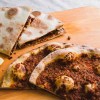Simple Crusty Bread



Here is one of the most popular recipes The Times has ever published, courtesy of Jim Lahey, owner of Sullivan Street Bakery. It requires no kneading. It uses no special ingredients, equipment or techniques. And it takes very little effort — only time. You will need 24 hours to create the bread, but much of this is unattended waiting, a slow fermentation of the dough that results in a perfect loaf. (We've updated the recipe to reflect changes Mark Bittman made to the recipe in 2006 after publishing and receiving reader feedback.

This is a sticky, no-knead dough, so, some sort of baking vessel, such as pyrex bowls (about 1-L or 1-qt) or ramekins for mini loaves is required to bake this bread. You can use a bowl that is about 2 qt or 2 L in size to bake off the whole batch of dough (versus splitting the dough in half) but do not use this size for baking half of the dough — it is too big.

To achieve the texture we found in Bari, Italy, the dough must be wet — so wet, in fact, it verges on a thick yet pourable batter. Resist the temptation to add more flour. Shaping such a sticky, high-hydration dough by hand is impossible. Instead, the dough is gently poured and scraped into the oiled baking pan; gravity settles it into an even layer.
If you have trouble finding Castelvetrano olives, substitute any large, meaty green olive.

One of our favorite variations of flatbread originated in Romagna, in northern Italy. There they throw together flour, salt, water or milk, and lard or olive oil to make a quick dough. After a short rest, the flatbread — a piadina — is cooked on a griddle or skillet. The cooked flatbreads then are stuffed with sweet or savory fillings and folded to make a sandwich.

These thin, crispy, savory meat-and-vegetable-topped Armenian flatbreads can sprayed with lemon juice and eaten like pizza, or turned into sandwiches by rolling them around a salad of fresh or pickled vegetables. Our dough started with a higher-protein all-purpose flour to create an ample amount of gluten that gave the dough both crispness and tenderness but not so much that it turned tough.

This bread, known as zhima dabing—which means big sesame pancake—is similar to Chinese scallion pancakes, but is much larger and thicker and has a lighter, fluffier crumb. If you’re unable to find sweet rice flour with the baking ingredients, check the Asian food aisle for a white box labeled “mochiko” (the Japanese term for the flour). Don’t use regular rice flour in , its place, as it won’t produce the same texture. And don’t use pre-toasted sesame seeds, while the seeds brown deeply as the bread cooks; toasted seeds may end up scorched and bitter.

We have to admit that gluten-free baked goods rarely blow our hair back. It’s just difficult to achieve the satisfying chew of wheat-based baked goods without the help of gluten. But tapioca starch’s unique qualities make it one of the best substitutes out there.
My objective here was to create bread that was really crusty when toasted and this certainly does that. The crust will be a bit chewy when untoasted but not crisp. If you like crusty toast, my suggestion would be to toast the bread on the high side of your normal toast setting.

Dinner rolls don’t have to be white and fluffy. These flavorful brown-bread rolls are chock full of a variety of tasty seeds and are sweetened with a touch of molasses. The dough resembles a whole-wheat challah, with a crisp crust and a light texture.